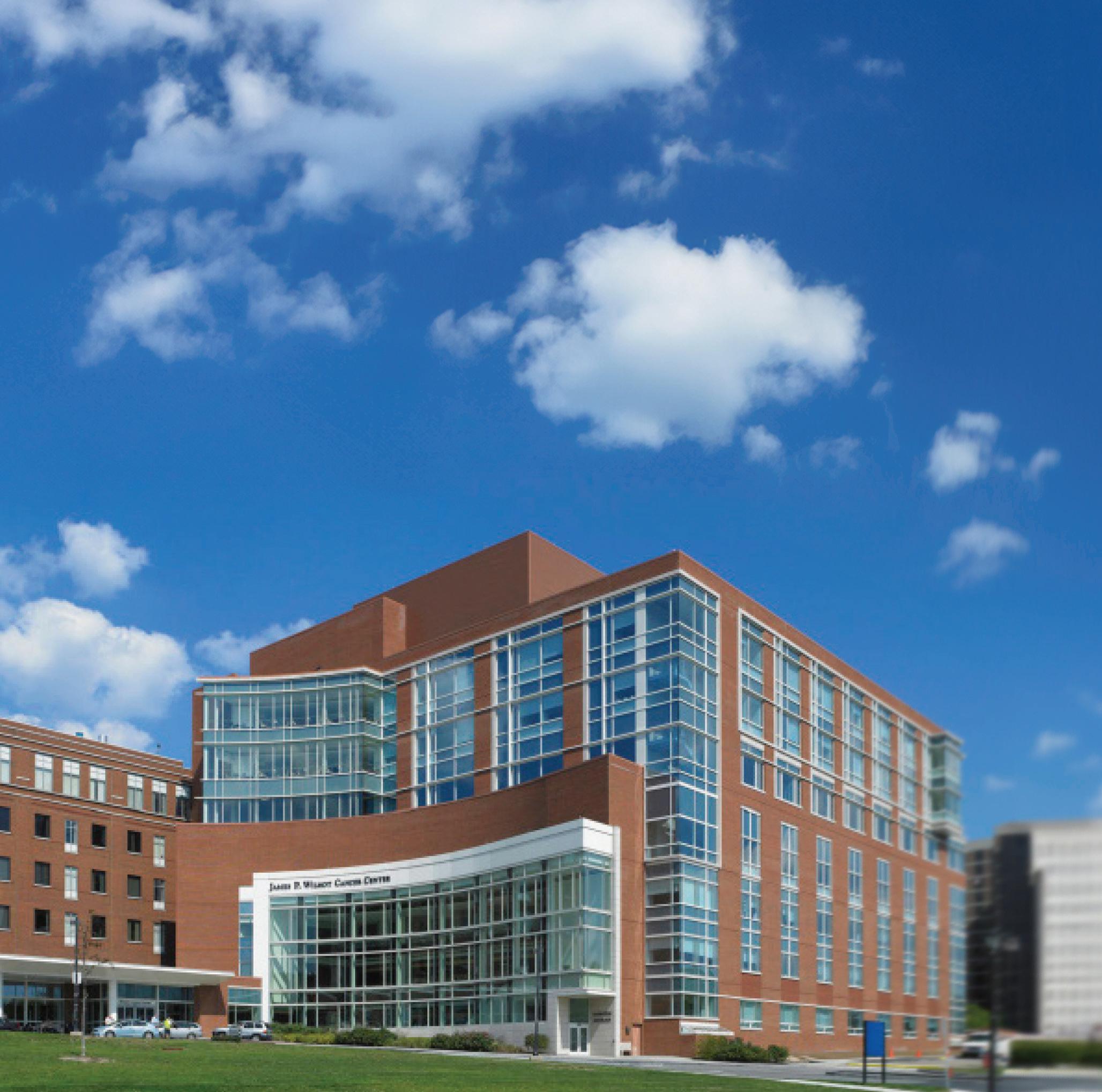
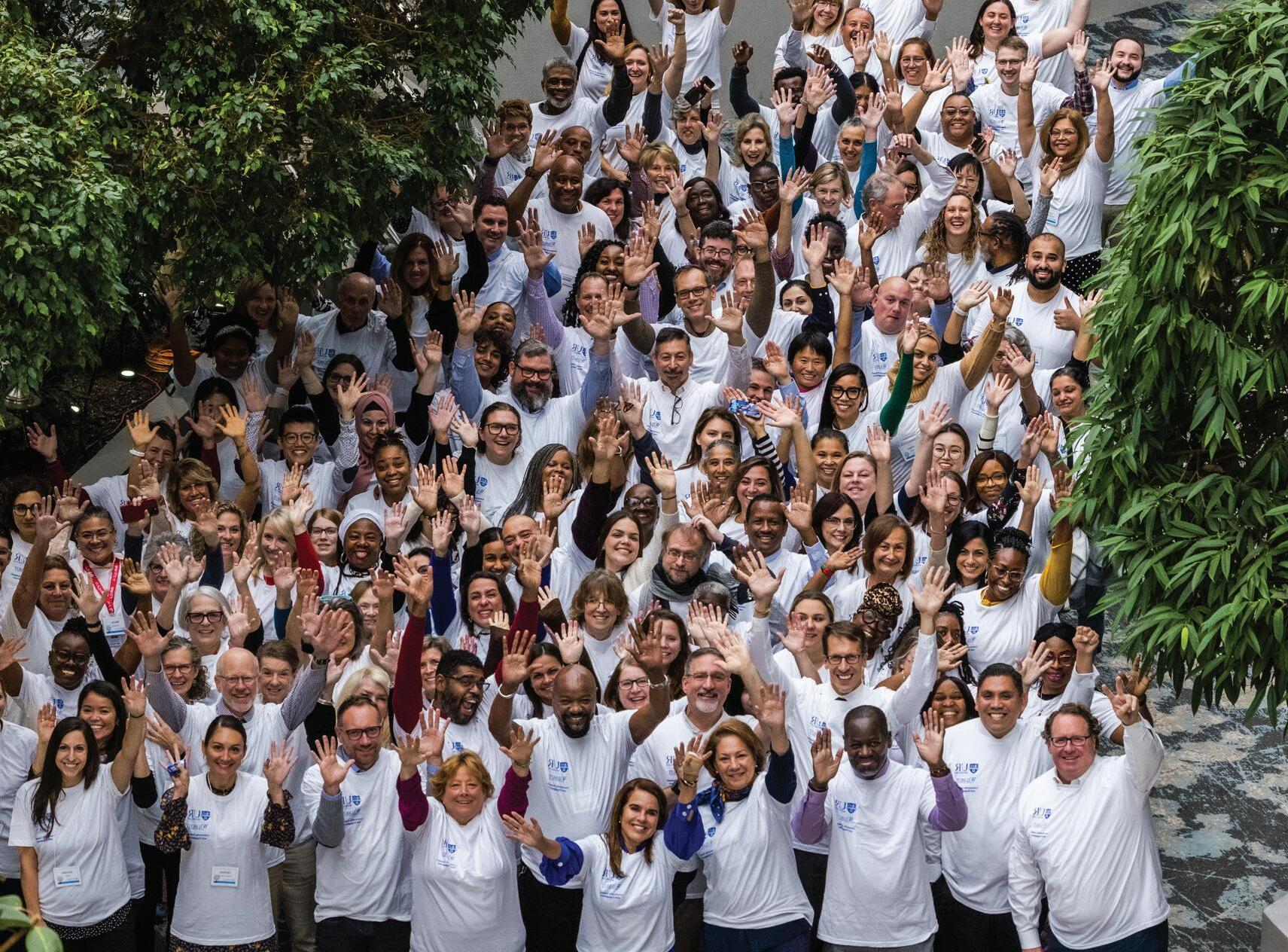
WILMOT CANCER INSTITUTE Strategic Plan 2023–2028
10–11
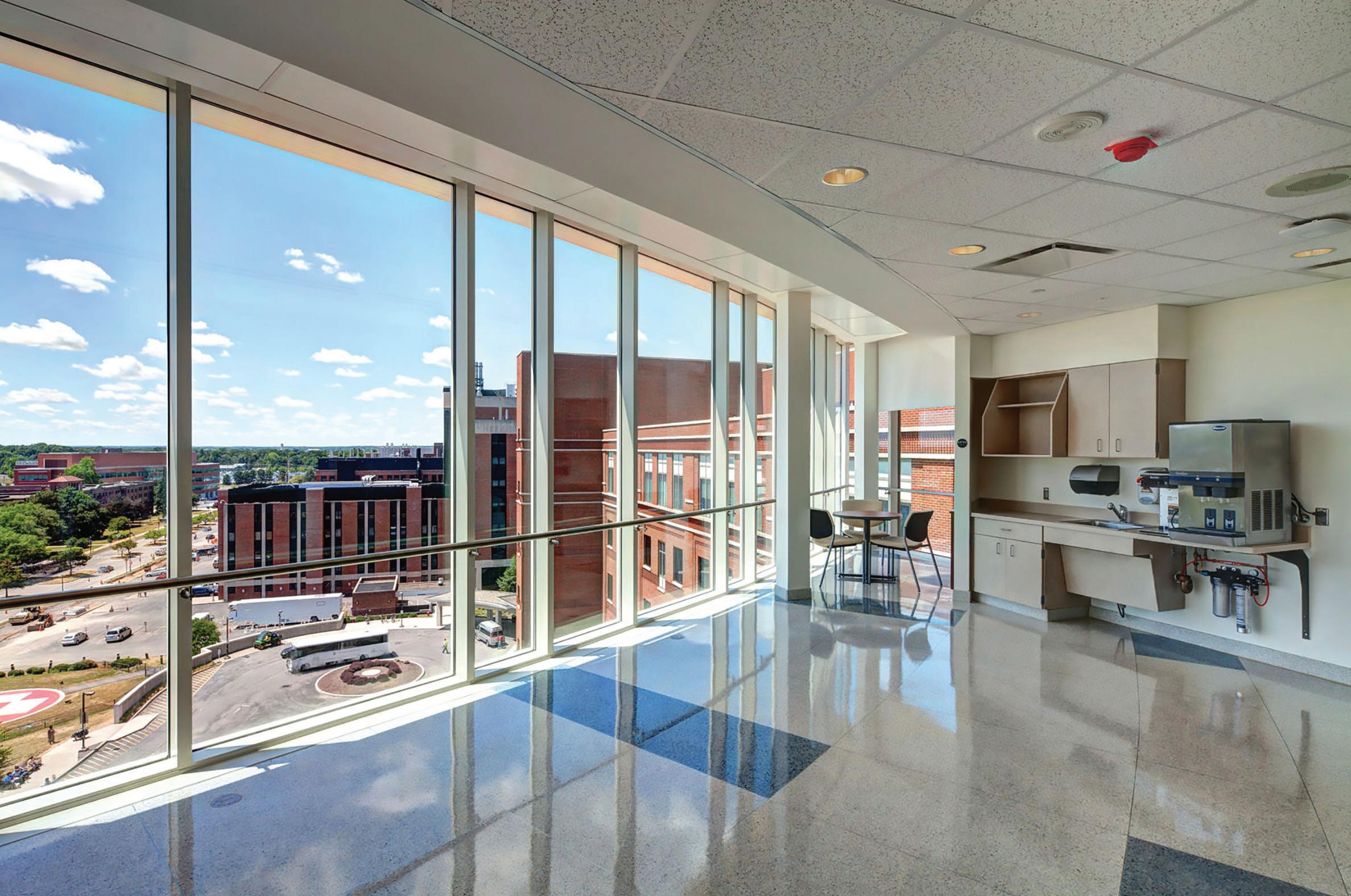

Strategic Intent
To improve the health of the community we will ignite, catalyze, and amplify our world-class cancer research, academic, and clinical expertise; our ability to innovate; and our collaborative and bold advancements to prevent, detect, treat, control, and defeat cancer.



3
Overview
Mission and Vision
By the Numbers 8–9 GOAL #1 Culture GOAL #2 Community
14–15
3
3–5
6
7
12–13
16–17 18–19


The catchment area is composed of a distinct population of more than 3 million people, including the highest per-capita Deaf population in the nation, who are confronted with a cancer incidence significantly higher than national averages due to a burgeoning aging population; an alarming smoking rate; and an abundance of predominantly poor urban and rural communities.
Providing care to people in this Western and Central New York region presents unique challenges. Wilmot is dedicated to meeting these challenges through world-class cancer research and clinical expertise.
Founded in 1974, Wilmot has achieved success by adhering to our original vision of providing patients and families comprehensive cancer care closer to where they live and work. Through our 13 locations, Wilmot has become the largest cancer care provider in Upstate New York, with the commitment that no patient will need to leave our region to receive the highest-quality cancer care.

The Institute boasts a leading geriatric oncology program, one of the area’s largest blood-and-marrow transplant programs, and innovative multidisciplinary care tailored to the individual patient.

To build on past success, we are forging a bold path toward the future through this 2023-2028 Strategy and Action Plan, which is the result of our entire team — researchers, clinicians, trainees, staff, and leadership — coming together for the benefit of the region. Most importantly, the plan was informed by engaging with our community to gain a better understanding of cancer’s local impact.
We are excited about the promise of this plan and what it will mean for the people in our care. Fulfilling the plan’s promise
than a thriving cancer center at our Medical Center. The University strongly supports this strategic vision of empowering dedicated clinicians, scientists, and staff to continue the quest to conquer all cancers. Working together, we will accomplish our goal of continuing to provide precision patient care for people with cancer.”
- Sarah C. Mangelsdorf, Ph.D., University of Rochester President, and David Linehan, M.D., CEO of the University of Rochester Medical Center and dean of the School of Medicine and Dentistry
5
VISION:

By the Numbers
191 CLINICAL TRIALS AVAILABLE 2023
1,429
351 TRAINEES WORKING WITH WILMOT MENTORS
MISSION:
Patients at Wilmot Cancer Institute will survive and thrive throughout the cancer journey while dedicated clinicians, scientists, and researchers continue the quest to conquer all cancers.

13
INTERVENTIONAL ACCRUALS IN 2023 CLINICAL LOCATIONS

$
30M ANNUAL DIRECT FUNDING
SHARED VALUES
Outstanding Patient Outcomes
Wilmot Cancer Institute is committed to providing world-class treatment and care, through expert and innovative medicine, science, and education, for any patient burdened by any cancer within our region and beyond.

114 MEMBERS

7,135
Pursuit of Excellence
Cutting-Edge Discoveries Diversity, Equity and Inclusion Teamwork and Collaboration Caring and Compassion Commitment to Our Region NEW CANCER CASES 2022

198 ONCOLOGY PHYSICIANS


514 ONCOLOGY NURSES
7
/ GOAL #1: Culture of Vitality and Collaboration
Wilmot achieves breakthrough discoveries and translates them into novel cancer treatments by bringing together experts from multiple backgrounds, perspectives, and disciplines.
As part of the University of Rochester, a leading research university, and the University’s academic medical center, Wilmot researchers thrive through ongoing collaboration across 20 academic departments and 30 clinical specialties.
From basic science to clinical trials, collaboration among research programs and cancer specialties is facilitated by co-localization on one campus — which is large enough to attract a critical mass of researchers from around the world, yet just the right size for interactions to take place on a close, personal level.
Wilmot will further our culture of vitality and collaboration by embracing diversity, equity, and inclusion across the institution. Central to this goal is addressing disparities in cancer care that exist among underrepresented and underserved populations, such as people in the Black, Latino, Indigenous, and Deaf communities in our catchment area. Through targeted recruitment and retention, we will build a more diverse team of faculty, scientists, researchers, nurses, and staff – one that builds trust by better reflecting the people in our region.


to highlight thought leadership and to serve as Wilmot ambassadors.
“To address the many disparities that exist in cancer care, we must have a workforce – physicians, nurses, researchers, and staff – that mirrors the community. If patients see a care team or clinical trial staff that looks like them, sounds like them, and that they can relate to ethnically or culturally, they are more likely to feel that
they can trust them.”
- M. Patricia Rivera,
M.D., Associate Director of Diversity, Equity, and Inclusion, Wilmot Cancer Institute

Priorities Actions
Nurture a workplace culture
of diversity,
Inclusion (DEI)
Partner with URMC and the University’s Office of Equity and Inclusion to enhance an integrated plan with Wilmot-specific actions to address diversity, equity, and inclusion goals
Create a “safe spaces” program for transformative conversations on DEI topics
Support the well-being, development, and satisfaction of faculty, staff, and learners
Foster broad and deep collaboration
Conduct the Wilmot Press Ganey employee satisfaction and engagement survey annually (utilize survey results to inform and guide our efforts to identify and address key cultural, workplace, and workforce issues)
Project a strong Wilmot identity of thought-leadership and bold achievement
Create cross-cutting opportunities for members of Wilmot scientific and research programs, disease working groups, and clinical services lines to work together with a specific focus on collaboration between basic scientists and clinical/population science investigators
Forge strong relationships and partnerships across diverse communities and throughout the Wilmot catchment area
Expand administrative infrastructure to support development and submission of multi-component grant applications
Promote Wilmot accomplishments and attend targeted conferences with abstract submissions to solicit selection/ invitation for speaking and presenting engagements
9
GOAL #2:
Reduced Impact of Cancer and No Disparities
In collaboration with the communities it serves, Wilmot aims to achieve equal cancer care for all in our catchment area by eliminating disparities in cancer incidence and outcomes.
Our Community Outreach & Engagement team works to address cancer disparities and strengthen relationships with underrepresented and underserved communities. Our Community Cancer Action Council (CCAC) reinforces this work and is empowered to inform research priorities and develop opportunities to address cancer-care disparities.
That empowerment is evident in the development of Wilmot’s strategic plan. CCAC leadership was integrated into its development, and approximately 200 community participants provided substantive input at a CCAC retreat. Much of that input centered on the strategic goals focused on Culture of Vitality and Collaboration and Reduced Impact of Cancer and No Disparities.
Part of the efforts to reduce cancer’s impact and disparities will involve addressing the gap between research and participation in clinical trials by reducing barriers to increase participation among diverse populations. To help achieve this, CCAC members will assist in reviewing clinical trials before they move forward to identify opportunities for inclusion.
Through community engagement, Wilmot will gain valuable input on unmet needs to create community-driven research and implement
targeted cancer prevention, outreach, and education programs to overcome cancer-related disparities. Through the recruitment of diverse faculty and staff, we will become an incubator for world-class leadership among underserved populations in health equity research, medical education, and clinical care.
“Listening to the voice of the community through the CCAC was important because it gave Wilmot an outside, 360-degree view – not just the viewpoints of researchers. The result is a meeting of the minds and a strategic plan focused on the priorities that we identified.”
- Michele Foster, MPA, Pivital Public Health Executive Director | CCAC Member
“The commitment to mobilizing other community organizations in the cancer space demonstrates the power of partnerships. It is true community engagement.”
- Don Armstrong, Director of Community Outreach & Engagement, Cancer Support Community at Gilda’s Club Rochester | CCAC Member
“Data collected on disparities in the communities tells the story. It will help direct Wilmot to where the work needs to be done.”
- Elisa DeJesus, MS, AT, Director of Language Services, Ibero American Action League | CCAC Member

Priorities Actions
Understand the impact of cancer and community health needs in the catchment area
Mobilize community partnerships to create a welcoming environment and implement cancer education and outreach initiatives
Disseminate data reports on the impact of cancer, internally and externally
Utilize data on cancer-risk factors and impacts across the catchment area to inform outreach efforts and the development of tailored interventions
Collaborate with the National Center for Deaf Health Research to investigate cancer burden within the Deaf community
Maintain diversity of the Community Cancer Action Council (CCAC) membership to reflect and represent catchment-area communities
Routinely survey CCAC partners regarding their satisfaction with Wilmot’s responsiveness to community needs and priorities
Provide culturally appropriate cancer education about research, clinical trials, cancer health disparities, prevention, and symptom management to catchment-area communities
Target outreach efforts to populations and communities with a high impact of cancer
Foster catchment-area relevant research and equitable access to clinical trials
Reduce the impact of cancer within and beyond the catchment area
Present information on cancer research and clinical trials in Spanish, American Sign Language (ASL), and other languages in a culturally appropriate way
Engage Black, Latino, Deaf, and rural communities to promote access to and remove barriers to clinical trials
Promote and disseminate evidence-based guidelines and policies informed by Wilmot research
Engage community organizations, health agencies, health care providers, county health departments, and NYS Department of Health to harmonize policy advocacy efforts
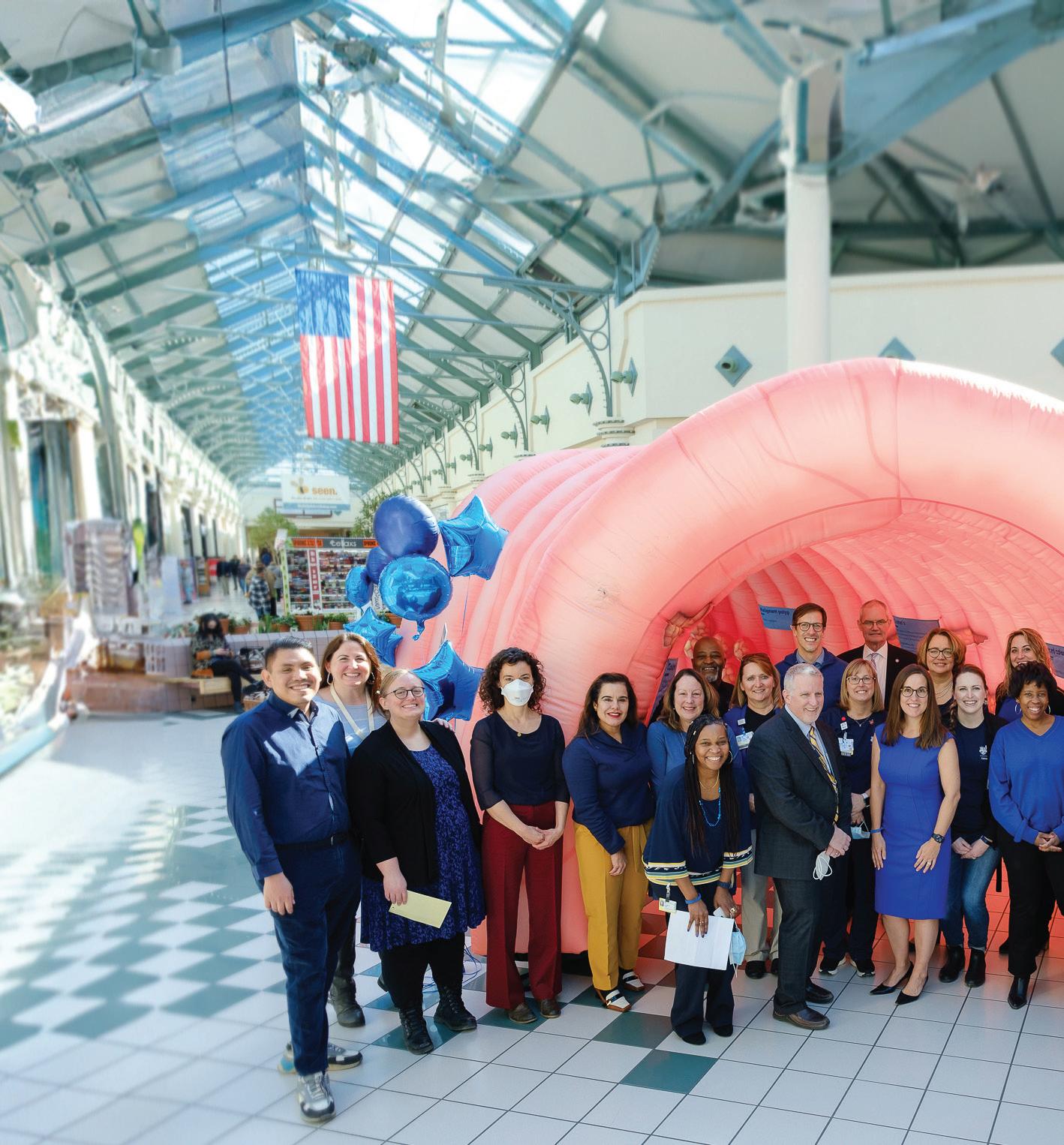

/
11
Breakthrough Cancer Research
For half a century, Wilmot research has led to paradigm-shifting discoveries and changes in national oncology standards of care. From the science behind the human papillomavirus (HPV) vaccine, to pioneering cancer-control techniques, groundbreaking hematological-disease research and novel approaches to pancreatic cancer, Wilmot scientists have been at the forefront of some of the most significant cancer-related breakthroughs.
Our research has one ultimate goal: to improve patient outcomes by converting scientific discoveries into transformational clinical therapies.
Future breakthroughs will result from collaboration on multidisciplinary and multi-investigator research projects. Undertaking program projects that employ complementary skill sets from teams both inside and outside of Wilmot and the University of Rochester, for example, will accelerate new research.
Expanding our research capabilities also will involve continuing recruitment of scientists and researchers with expertise in a range of disciplines, including aging biology, bioinformatics, cancer metabolism, cancer-omics, and innate immunity. Our
developmental therapeutics capabilities will expand through greater investment and the recruitment of investigators, increasing capacity for conducting early-phase clinical trials and enhancing the translation of discoveries for clinical applications.
At the heart of our innovations is fostering research most relevant to the unmet needs of the people in our Central and Western New York catchment area. Through community outreach and engagement, we will advance research that has a direct impact on the catchment area and further educate the community about our clinical trials.

As a research institution, our goal is to develop scientific discoveries that benefit patients first. We strive to accomplish this by expanding community engagement to inform our research. We strongly value multidisciplinary research, an approach that enables us to make basic science discoveries and to translate them for high clinical impact.”
- Laura M. Calvi, M.D., Co-Leader, Cancer Microenvironment Research Program, Wilmot Cancer Institute
Priorities Actions
Advance and accelerate innovative cellular and molecular research
Continue investing in aging-related cancer research across all research programs
Recruit and retain the requisite faculty expertise to advance and expand innovative research
Invest in shared resources and continually expand access to advanced techniques, such as developing a metabolism shared resource
Broaden transdisciplinary research and high-impact interventional treatment trials
Provide developmental funds and administrative support for:

Intra/inter-programmatic multidisciplinary multicomponent applications in Myelodysplastic Syndromes and Pancreatic Cancer Metastasis

Intra/inter-programmatic multi-investigator (MPI) grants
New collaborative research projects
Catchment area-relevant research
Significantly invest in developmental therapeutics

/ GOAL #3:
13
Innovative Cancer Prevention and Control Science
Imagine a world without lethal cancers because they are either cured or prevented from ever developing in the first place. Environmental toxins are eliminated. People make lifestyle changes, from exercising and eating nutritious foods to stopping smoking and drinking less alcohol. Not only would people enjoy a healthier quality of life, but it would lessen the health care costs associated with the disease.
Finding cures for various cancers or preventing the disease completely are ultimate goals. In the meantime, Wilmot is committed to conducting research to detect cancer early, treat it effectively, alleviate the negative impacts of treatment, and to ease cancer’s burden on people.
Wilmot has been at the forefront of prevention breakthroughs since pioneering investigations leading to the human papillomavirus (HPV) vaccine. These innovations will continue through enhanced research on prevention and on developing more accurate screening methods. Just as crucial is increasing participation in screenings.
For people diagnosed with the disease, our scientists are focused on supporting current patients and survivors through research that deals with the toxicity and side effects of cancer treatments — those that occur during treatment as well as the chronic effects that can
affect survivors’ daily lives. Clinical trial accrual will increase by improving accessibility among underserved and underrepresented populations.
Wilmot is also working to better understand and address cancer’s biological and physiological impacts. Through a team-science approach, we are connecting the cancer-control field with basic science for the benefit of people with cancer. Collaborating with basic scientists, community partners, patients, and patient advocates will achieve faster and better results, at a lower cost.
“We want to prevent cancer from ever happening. If we can’t prevent it in a patient, we want to develop more accurate screening methods to find it as soon as possible. When we find cancer, we want to make a difference, especially in underserved and disenfranchised communities, by mitigating the effects of treatment and by easing cancer’s burden on patients, their families, their
friends, and caregivers.”
- Karen M. Mustian, Ph.D., M.P.H., Co-Leader of the Cancer Prevention and Control Research Program, Wilmot Cancer Institute



Priorities Actions

Recruit the requisite faculty expertise to advance and expand innovative Cancer Prevention and Control (CPC) research in cancer epidemiology, cancer disparities, and lifestyle intervention
Focus attention on initiating funded cancer prevention studies to overcome catchment-area health disparities
Expand research directly impacting the catchment area
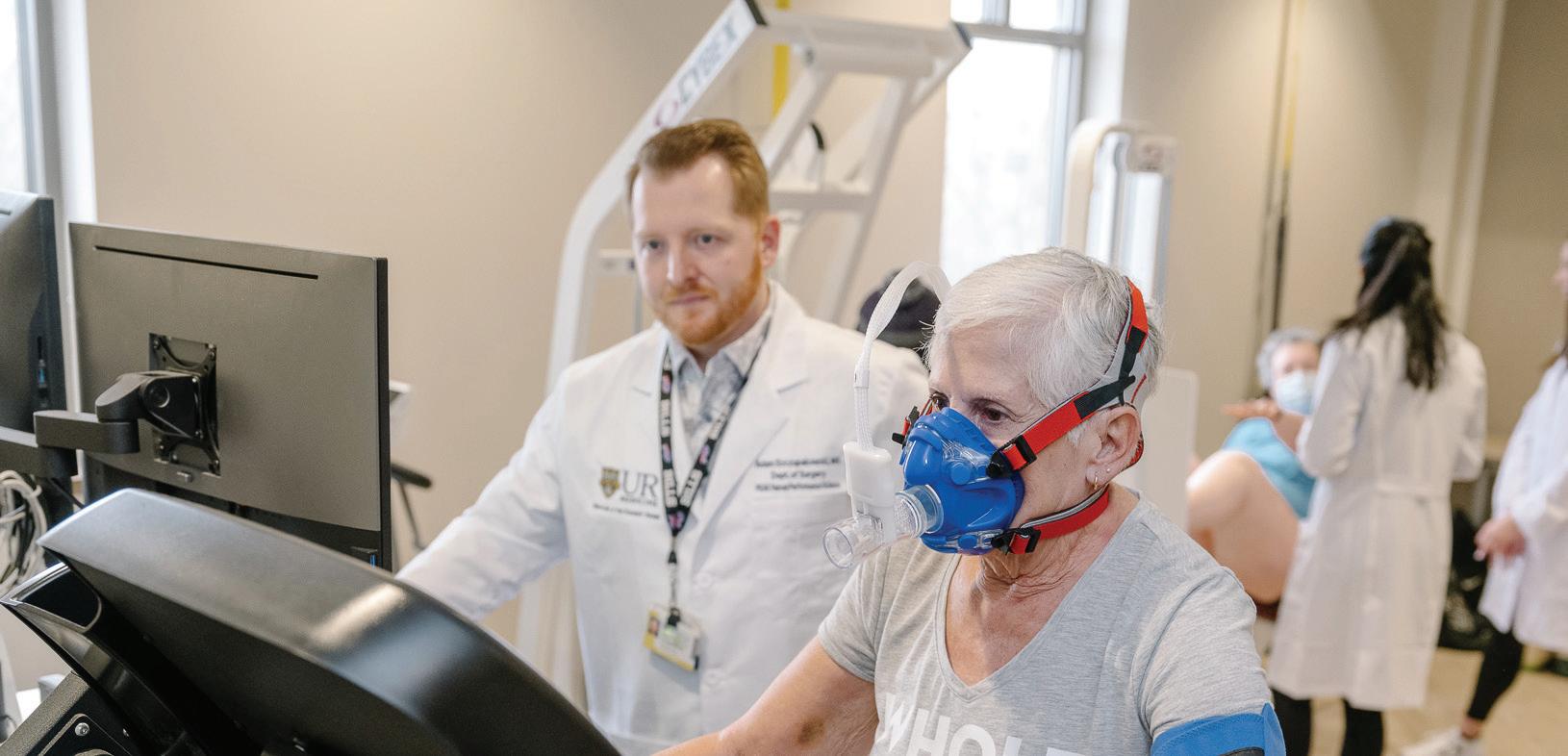
Recruit and retain the requisite faculty expertise to advance and expand innovative CPC research in exercise genomics and epigenomics, implementation science, palliative and survivorship care
Invest in the Human Biophysiology Shared Resource to support growth of CPC research
Expand pipeline to translate Wilmot catchment-area CPC clinical trial discoveries into definitive phase III nationwide trials
Integrate with basic science to define and interrogate mechanisms
Foster collaboration between CPC and laboratory-based research programs through targeted developmental funds
/ GOAL #4:
15
Superior Cancer Treatment and Care
Receiving a cancer diagnosis is a life-altering moment, and the emotional impact on a patient can be overwhelming. Any delay in care simply adds to a patient’s distress.
Wilmot is committed to providing the highest-quality patient care in a timely manner. We will put all our efforts into seeing and treating patients as quickly as possible.
Central to expedited quality patient care is creating new information systems that improve internal processes, such as a patient-scheduling-tracking system and emergency-room monitoring to keep patients with cancer out of the ER whenever possible.
Finding cancer early is key, through promoting and engaging in community cancer screenings, including breast, cervical, colon, and lung-cancer screenings. Cancer screenings will be expanded to reach more people in underserved rural and urban communities. And we will build on our successful Hereditary Cancer Screening and Risk Reduction Program to identify more patients who are eligible for the program.
By continuing to add depth and breadth to our research and science expertise, we will treat more patients and significantly increase participation in clinical trials — preserving Wilmot’s status as one of
the top sites for accruals within the NCI National Clinical Trials Network, and earning renewal of our Lead Academic Participating Site NCI award.
Wilmot will be the cancer-treatment and care-destination center in Western and Central New York and across the state, achieving patient outcomes that exceed the national average.
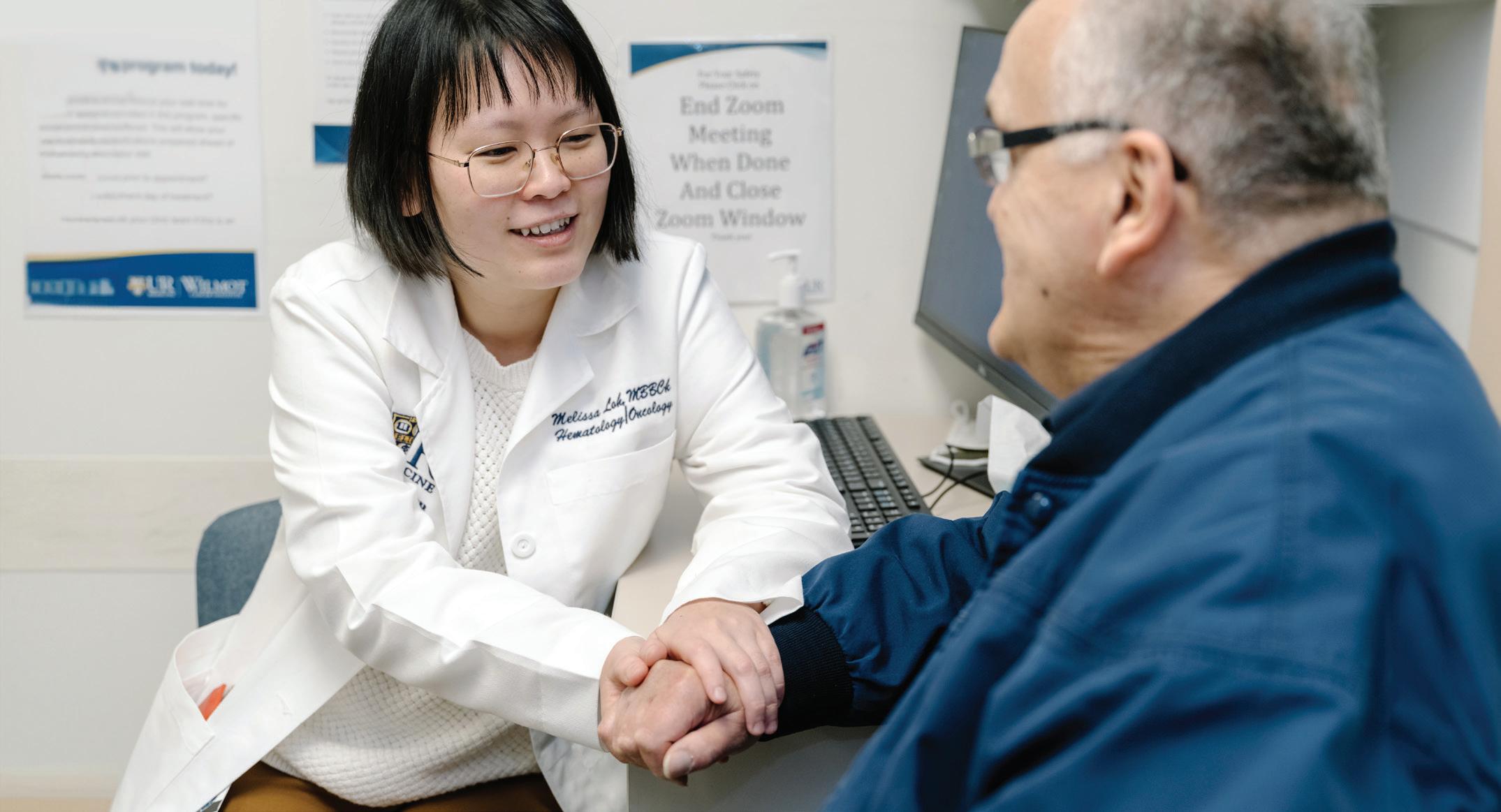
“When patients come to Wilmot, they will get the best-possible care experience. We will be successful in providing superior cancer care
by
treating patients faster, by expanding our team of the best and brightest researchers, scientists, and oncologists, and by building our expertise for more clinical trials.”
- Daniel Mulkerin, M.D., Medical Director and Associate Chief Medical Officer, Wilmot Cancer Institute


Priorities Actions
Pursue world-class
Leverage clinical systems in support of the research and academic missions

Develop information systems to support process improvement
Promote cancer screenings
Participate in the National Mammography Database and the Lung Cancer Screening Database
Create and support a community oncology network
Recruit clinicians with targeted research/clinical expertise
Enhance regional capacity for clinical trial accruals
Expand nursing involvement in clinical trial management and execution
Leverage new technologies toward precision clinical care and research
Implement processes to ensure that nurse navigators identify barriers to care for all newly diagnosed cases
Enhance patient navigation across different specialties and regional sites
Deliver multispecialty, multidisciplinary team care in physical and virtual settings
Open a women’s cancer center, offering imaging, surgery, and integrative oncology services, among others
Expand teaching tools appropriate for Deaf patients (Rochester, N.Y. has the largest Deaf population of any cancer center in the nation)
/
GOAL #5:
17
#6:
Center of Excellence in Education
For the best cancer research and treatment, we need dedicated and skilled professionals. Wilmot’s faculty is renowned for its expertise and commitment to training the next generation of clinicians and researchers.
Wilmot has a coveted NCI-supported T32 grant to recruit and train faculty in clinical and translational cancer-control research, and the University holds an additional four cancer-related NIH T32 grants. With a $12 million endowment, the unique Wilmot Research Fellowship program has supported more than 100 early career physician investigators over four decades.
Achieving future innovative laboratory discoveries in cancer research requires a continuous pipeline of science learners. Wilmot is committed to cultivating this pipeline by enhancing education and training programs and encouraging early learners to choose a career path as a scientist or an oncologist.
Wilmot is dedicated to addressing gaps in the STEM training pipeline, such as the shortage of learners from diverse backgrounds and underrepresented communities. Our goal is to strengthen ongoing efforts to ensure that our clinicians and staff reflect the communities we serve, by promoting greater diversity. We plan to achieve this by creating diverse fellowship programs, securing additional education and training grant funding, collaborating with high schools to identify
prospective students, and implementing career enhancement initiatives.
Through bold, new curricula and learning modules in cancer for early learners, our renowned educational programs will continually evolve to serve patient needs better.

“A continuum of early science learners, from high-school level through early-career researchers, is critical to achieving new cancer-research discoveries. Our plan for building on Wilmot’s position as a center of excellence in cancer education is to expand our educational programs to reach underserved communities and to encourage more learners with diverse backgrounds to enter our education programs as early as possible.”
- Nicole O’Dell, Ph.D., Research Assistant Professor Department of Medicine, Hematology/Oncology (SMD), Wilmot Cancer Institute

After completing her doctorate at the University of Rochester, Nikesha Gilmore was unsure that a career in academia aligned with her career goals. However, after learning about the T32 program while working as a project manager, she got a different view of what her future research career could be, so she applied to the program. As a T32 program graduate, Gilmore currently studies biological markers of aging and frailty-related complications in older adults with cancer, with a focus on equitable outcomes for older Black patients with cancer.
“Wilmot’s T32 program is unique because it allows me to conduct research that I’m passionate about, and it gives me the support that I need,” Gilmore said. “My primary mentors as well as other mentors within the T32 program provide constant guidance, from giving feedback to a grant application to helping me set up my first pilot project and sharing their data. I stayed here after my Ph.D. because of my mentors at Wilmot. Any question I ask always gets the same response: ‘Let’s see how we can figure this out.’ I don’t think I’d get this level of support anywhere else.”

Priorities Actions

Encourage early learner engagement in cancer-related science
Leverage established institutional expertise, programs, and resources relevant to education in the achievement of Wilmot’s goals
Collaborate with the Rochester City School District and the UR David T. Kearns Center to implement a Youth Pipeline Program for high-school students
Support and expand cancer research training, career enrichment, and professional development opportunities
Support self-guided development and expansion of the multidisciplinary Cancer Research Interest Group for pre-and post-doctoral learners
Strengthen the pipeline of pre-doctoral and post-doctoral learners from underrepresented groups training in Wilmot member labs
Create a welcoming training environment for a diverse community of cancer-focused learners
Establish a strong mentoring program for learners from underrepresented groups across the learner continuum from high school through ongoing career progression
Continue to recruit, educate, and mentor learners from underrepresented groups
/ GOAL
19
